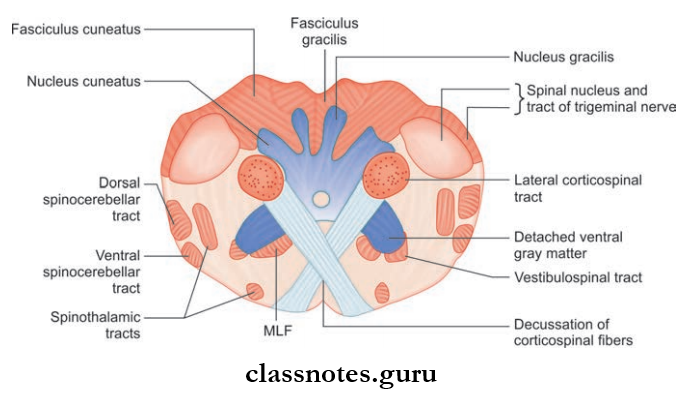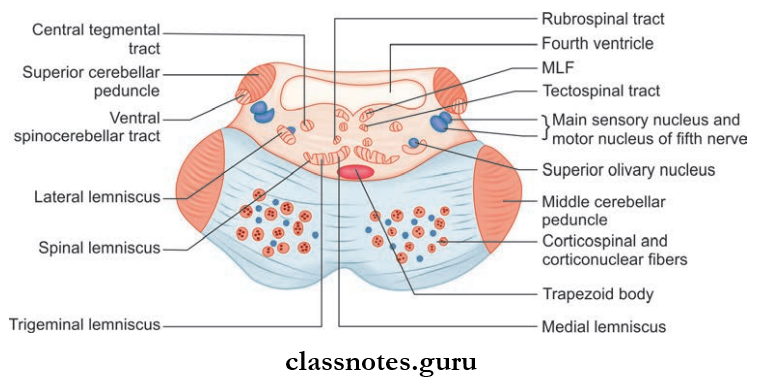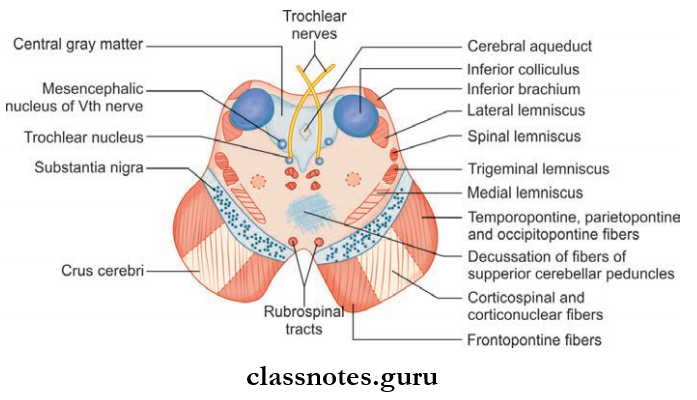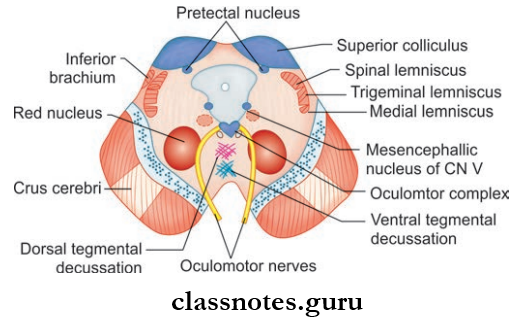Brainstem Question And Answers
Question 1. Write a short note on the transverse section of the medulla at the level of decussation of the pyramid.
Answer:
The Transverse Section Of Medulla At Level Of Decussation Of The Pyramid
Resemble the transverse section of the spinal cord and pass through the inferior half of the medulla.

Abbreviation: MLF—Medial longitudinal fasciculus
Decussation Of Pyramid Gray Matter
- Pyramidal fiers separate the anterior horn from the central gray matter
- The anterior horn forms the spinal nucleus of the accessory nerve
- Central gray matter is pushed backward
- Nucleus gracilis and cuneatus are continuous with central gray matter
- Central gray matter is continuous with the nucleus of the spinal tract of the trigeminal nerve.
Decussation Of Pyramid White Matter
- Pyramids anteriorly
- Decussation of pyramidal tracts
- Fasciculus gracilis and cuneatus occupy the posterior column
- Other features of white matter is similar to the spinal cord.
Question 2. Write a short note on the transverse section of the medulla at the level of sensory decussation.
Answer:
The Transverse Section Of The Medulla At The Level Of Sensory Decussation
The section passes through the middle of the medulla and the following features are seen.

Abbreviation: MLF—Medial longitudinal fasciculus
Sensory Decussation Gray Matter
- The nucleus gracilis and cuneatus are larger and separate from the central gray matter
- Accessory cuneate nucleus which relays unconscious proprioceptive fiers from upper limbs
- The nucleus of the spinal tract of the trigeminal nerve is separated from the central gray matter
- The lower part of the inferior olivary nucleus seen
- Central gray matter contains a hypoglossal nucleus, dorsal nucleus of the vagus, and nucleus of tractus solitarius.
Sensory Decussation White Matter
- The nucleus gracilis and cuneatus give rise to internal arcuate fibers which cross to the opposite side and form a band of fibers called medial lemniscus
- Pyramidal tracts anteriorly
- Medial longitudinal bundle posterior to the medial lemniscus
- Spinocerebellar, lateral spinothalamic tracts in the anterolateral area.
Question 3. Write a short note on the transverse section of the medulla at the level of olives.
Answer:
The Transverse Section Of The Medulla At The Level Of Olives
The section that passes through the floor of the fourth ventricle shows the following features.
Olives Gray Matter: Nuclei of cranial nerves
- Hypoglossal nucleus
- Dorsal nucleus of the vagus
- Nucleus of tractus solitarius
- Inferior and medial vestibular nuclei.

Abbreviation: MLF—Medial longitudinal fasciculus
- The nucleus ambiguity lies deep in the reticular foramen
- The dorsal and ventral cochlear nuclei lie on the surface of the inferior cerebellar peduncle
- The nucleus of the spinal tract of the trigeminal nerve
- The inferior olivary nucleus is the largest mass of gray matter and appears like a crumpled purse
- The arcuate nucleus lies anteromedial to the pyramidal tract.
Olives White Matter
- Inferior cerebellar peduncle in the posterolateral part
- Olivocerebellar fibers
- Stria medullaris is the floor of the fourth ventricle
- Ascending tracts
- Emerging fiers of 9, 10, 11 nerves.
Question 4. Write a short note on the transverse section of pons at the level of facial colliculus.
Answer:
The Transverse Section Of Pons At The Level Of Facial Colliculus
The section passes through a lower level of pons and the following features are seen.

Abbreviation: MLF—Medial longitudinal fasciculus
Facial Colliculus Gray Matter
- The abducent nerve nucleus lies beneath the facial colliculus
- The motor nerve nucleus of the facial nerve lies ventrolateral to the abducent nucleus
- Superior salivatory, inferior salivatory and lacrimatory nuclei lie medial to motor nuclei of the facial nerve
- The nucleus of tractus solitarius lies lateral to the superior salivatory nucleus
- The vestibular nucleus lie beneath the vestibular area
- Dorsal and ventral cochlear nuclei lie dorsal and ventral to inferior cerebellar peduncle
- The spinal nucleus of the trigeminal nerve lies anteromedial to the inferior cerebellar peduncle.
Facial Colliculus White Matter
- Trapezoid body present posterior to basilar part of pons
- Medial lemniscus in the anterior part of the tegmentum
- Spinal lemniscus lying lateral to medial lemniscus
- Medial longitudinal bundle occupying a paramedian position
- Tectospinal tract lying ventral to median longitudinal bundle
- Spinal tract to trigeminal nerve lying lateral and dorsal to motor nucleus of facial nerve.
Question 5. Write a short note on the transverse section through the upper part of the pons.
Answer:
Transverse Section Through The Upper Part Of Pons
This section passes through the trigeminal nuclei and the following features are seen.

Abbreviation: MLF—Medial longitudinal fasciculus
Upper Part Of Pons Gray Matter
- The motor nucleus of the trigeminal nerve is situated beneath the lateral part of the fourth ventricle
- The sensory nucleus of the trigeminal nerve is present lateral to the motor nucleus of the facial nerve.
Upper Part Of Pons White Matter
- Consists of ascending tracts as in the lower part of pons
- The lateral lemniscus is well-formed
- The spinal lemniscus lies in between the medial and lateral reminisce
- Trigeminal lemniscus is seen between medial and spinal reminisce
- Superior cerebellar peduncle lie dorsolateral to the fourth ventricle
- The medial longitudinal bundle is seen.
Question 6. Write a short note on the transverse section of the midbrain at the level of inferior colliculus.
Answer:
Transverse Section Of The Midbrain At The Level Of Inferior Colliculus
The section of the midbrain at the level of the inferior colliculus shows the following features.

Inferior Colliculus Gray Matter: The central gray matter contains the following
- Trochlear nerve nucleus in the vertical part
- The mesencephalic nucleus of the trigeminal nerve in the lateral part.
- Nucleus of the inferior colliculus, an ovoid mass of gray matter below the inferior colliculus
- Substantia nigra.
Inferior Colliculus White Matter
- The decussation of superior cerebellar peduncles in the central part
- Arrangement of reminisce to form a curved compact band in the ventral part
- The medial longitudinal fasciculus (MLF) lies on the side of the medial plane ventral to the trochlear nerve nucleus.
Question 7. Write a short note on the transverse section of midbrain at the level of the superior colliculus.
Answer:
Transverse Section Of Midbrain At The Level Of The Superior Colliculus
The section shows gray and white matters with the following features.

Superior Colliculus Gray Matter: The central gray matter containing
- The oculomotor nucleus in the ventral part
- The mesencephalic nucleus as in the lower part of the midbrain.
- Nucleus of superior colliculus
- The pretectal nucleus lying deep in the superolateral part of the superior colliculus
- The red nucleus presents vertically to the third nerve nucleus.
Superior Colliculus White Matter
- Decussation of fibers from superior colliculus forming dorsal tegmental decussation
- Decussation of fibers arising from red nuclei forming ventral tegmental decussation
- MLF lying ventrolateral to oculomotor nerve.
Brainstem Multiple Choice Question And Answers
Question 1. The transverse section of the medulla at the level of olives shows all of the following except:
- Hypoglossal nucleus
- Nucleus of tractus solitarius
- Nucleus cuneatus
- Nucleus ambiguous
Answer: 3. Nucleus cuneatus
Question 2. All of the following nuclei are found in pons at the level of facial colliculus except:
- Abducent nucleus
- Motor nucleus of trigeminal nerve
- Motor nucleus of the facial nerve
- Cochlear nuclei
Answer: 2. Motor nucleus of trigeminal nerve
